Vadodara, also known as Baroda, is one of the popular cities in Gujarat. The city is located on the banks of the Vishwamitri River, the water stream named after rishi Vishwamitra. The name Vadodara is a dedication to its former ruler, Sayajirao Gaekwad III (1875-1939 AD). It was called as Chandravati, after its ruler Raja Chandan, then Viravati, which means ‘house of the brave’ and Vadpatra, as it featured plenty of banyan trees. The present name of Vadodara originated from Vadpatra.According to historians, Vadodara's history is over 2,000 years old and the city has been ruled by Hindus, Pathans, Mughals and Marathas. Baroda saw the settlement of traders during 812 AD and was dominated by the Hindu kings until 1297. During the early years of the Christian era, the town was ruled by the Gupta Empire and was taken over by the Chalukya Dynasty. With the spread of Muslim rule in the country, the city was ruled by the Delhi Sultans who were later overthrown by Mughal emperors. Finally, the Marathas took over the region from the Mughals.
How to reach here:
By Air :Vadodara has an airport that is located outside the city and it has regular to flights to many important cities in the country such as Mumbai, Delhi, Kolkata, Ahmadabad, Chennai and Bangalore.
By Rail: The Vadodara Railway Station is an important part of the rail network in the state and there are frequent rail services from different places such as Mumbai (Dee Bdts G Rath), Chennai (Navjeevan Exp), Delhi (Mumbai Rajdhani), Bangalore (Coimbatore Exp) and most of the other places in the country.
Best time to visit: October to March.
Languages spoken: Gujarati, Hindi and English.
Must eat: Methi na Gota,Dahi Vada, Kansar, Jalebi.
Famous Restaurants: Kai Asia, Offside Lounge, 22nd Parallel, Azure, Barbecue nation.
Places you must visit:
Aurobindo Ashram served as the residence of Aurobindo Ghose during his stay in Baroda (1894 - 1906) as private secretary to HH Sayajirao Gaekwad III, Maharaja of Baroda. During this period, Aurobindo Ghose was also the Professor of English and vice-principal of Baroda College (now MSU). In the following years, he gained glory as a social and political thinker, a freedom fighter, a philosopher and a yogi, named Sri Aurobindo.The bungalow was then visited by famous people like Lokmanya Tilak, Bipin Chandra Pal, Sister Nivedita and Sakharam Ganesh Dueskar. Frequent visitors included wife Mrinalini Devi, sister Sarojini Devi and younger brother Barindar Kumar Ghose. The Niwas is now an ashram housing a library of Aurobindo literature, a study room and a sales emporium. The ashram features relics of Sri Aurobindo, and is open to all for meditation.



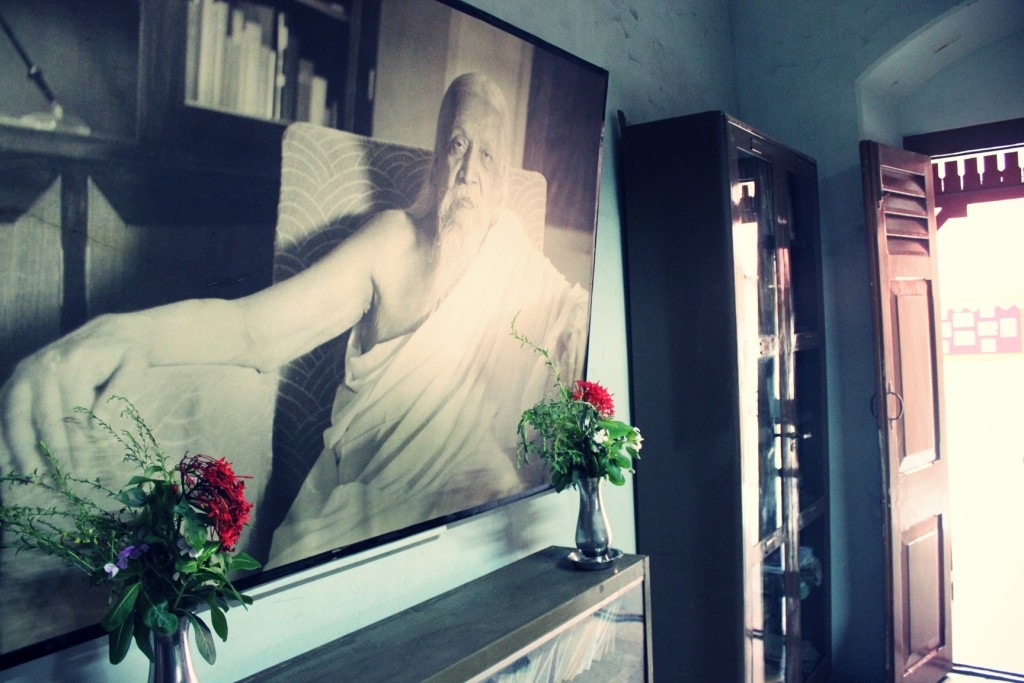
Maharaja Sayajirao University, commonly referred as M. S. University (MSU), is a teaching and residential university serving as one of the premier institutions of India. It was established in 1949 by Pratap Singh Gaekwad of Baroda, who named it after his grandfather Maharaja Sayajirao Gaekwad III. The university has its origins in the Baroda College of Science, which was established in 1881 by the Baroda State.The main building of this university, now housing the Faculty of Arts, was designed by Robert Fellowes Chisholm. Posing an Indo-Saracenic architecture style, the building features a confluence of Indian and Byzantine arches, and domes in brick and poly chrome stone. Other attractions of the university are Faculties of Fine Arts and Performing Arts and the Hansa Mehta Library that has over 700,000 books and old journals.The M. S. University offers education in all fields, including science, commerce, arts, law and many more. Unlike other universities in Gujarat, the medium of instruction for all courses in MSU is English. Spreading over approximately 275 acres of land, this university has roughly 25000 students on its rolls.


Laxmi Vilas Palace is a huge building of the Indo-Saracenic school that was built by Maharaja Sayajirao Gaekwad III in 1890. Designed by Major Charles Mant, this building is said to have been the largest private dwelling built till date. The interiors of this palace are reminiscent of a large European country house, and feature modern amenities like elevators. Presently, the palace serves as the residence of the royal family of Baroda.A striking feature of the palace is its Darbar Hall, which often serves as the venue of music concerts and other cultural events. Characteristic of a Venetian mosaic floor, Belgium stained glass windows and walls decorate with mosaic, this hall opens into an Italianate courtyard of water fountains. Besides, the 700 acres compound of the palace also houses other buildings such as the Moti Baug Palace and the Maharaja Fateh Singh Museum.The museum exhibits a rich collection of art works that belong to the royal family, including paintings of Raja Ravi Varma and others depicting Hindu mythology. Entrance of this beautiful museum is marked by a refurbished train engine of what was once a miniature railway line. Evidences of the past can be found elsewhere in the palace as well, such as the old armoury and sculptures in bronze, marble and terracotta by Fellici.



Kirti Mandir, or the Temple of Fame, is situated near the Vishwamitri Bridge towards the north of Maharaja Fateh Singh Rao Gaekwad's statue. This cenotaph was built by Maharaja Sayajirao Gaekwad III in 1936 to commemorate the cremation of his family members, and celebrate the diamond jubilee of his administration. Shaped like the alphabet 'E', this stone building is characteristic of domes, terraces and balconies.The 33 m high central shikhar is adorned with the sun, the moon and the earth in bronze and an undivided map of India. Inside the cenotaph are various rooms, featuring with the statues and photographs of the members of the royal family. The marble walls of this temple are decorated with the murals Gangavataran, battle of Mahabharata, Life of Meera and Natir Pooja, executed by the famous Bengali artist Nandalal Bose.
%20Vadodara%20Gujarat3.jpg)
,+Vadodara,+Gujarat12.jpg)
Tambekar Wada is a spacious, four-storey building that has been constructed in an oblong fashion. It is originally the former residence of the Baroda State Diwan or Minister, Bhau Tambekar, who owned the responsibility of the administration of the state. The walls, doors and ceilings on the first and second floors of this old fashion building are adorned with the best specimens of mural paintings dating back to 17th and 18th centuries.Other wall paintings dating back to the first half of the 19th century represent epic scenes depicting the life of the people. As the paintings have been made by some careless people, most of them had to be restored by the Archaeological Survey of India. The ASI still attend to the chemical treatments of these paintings on a frequent basis.



The scenic and impressive Vadodara Museum and Picture Gallery was built in 1894 AD by the Gaekwads. The museum has on display innumerable an extensive collection of artefacts relating to archaeology, geology, natural history and a variety of personal collection pieces of Maharaja Sayajirao III. Amongst the notable display, you can view the 109 miniature paintings of the Mughal times, a Persian version of Mahabharata specially commissioned by Mughal Emperor Akbar, 11th century Shiva Natraj amongst others.

Sayaji Gardens, popularly known as Kamati Baug, is the largest garden in Western India, spreading over 45 hectares of land. The garden is named after Maharaja Sayajirao Gaekwad III, who built it in 1879 on the river Vishwamitri. Besides the rich flora of more than 98 species of trees, this park encompasses two museums, a zoo, a planetarium and a flower clock.Built in 1894, the Baroda Museum and Picture Gallery within Sayaji Baug preserves a rich collection of art, sculpture, ethnography and ethnology. Major attractions of this museum include Egyptian mummy and skeleton of a blue whale. The picture gallery, which was opened in 1921, exhibits art works of British painters.The Floral Clock standing erect inside the park is the first of its kind in the state. The machinery of the clock is underground, and its hour, minute and seconds hands move on a 20 ft diameter dial.
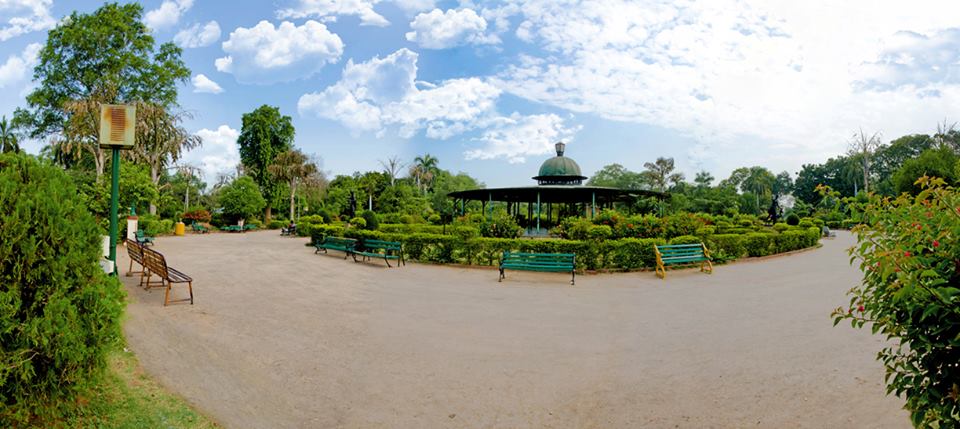


EME Temple, often referred as the Dakshinamurti Temple, was built by the Electrical and Mechanical Engineering (EME) Corps. Featuring an unusually modern geodesic architecture, this temple is dedicated to Dakshinamurti, a form of Shiva as supreme teacher. It is run by Indian Army Authorities, and incorporates holy symbols of all religions in one place as they do not have separate places of worship for different faiths.Depicting army architecture, the aluminium building of this temple is ringed by a garden featuring a rich collection of 106 ancient statues from the 6th to the 16th centuries.

Qutbuddin Hajira is the mausoleum of Qutbuddin Muhammad Khan, who was a general in the army of Mughal Emperor Akbar and later the governor of his region. Locally known as Hajira, this monument is certainly the most important Mughal monument in Vadodara. Built in 1586, the tomb features beautifully carved stone windows and an old step-well in the large grounds surrounding it.
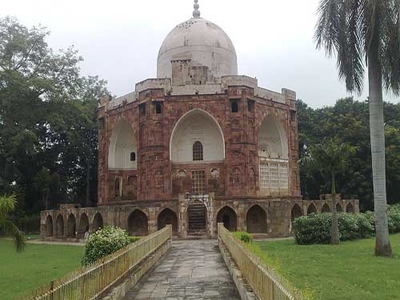
Mandvi Gate, often termed as the North gate of the Royal Enclosure, is one of the major landmarks in Vadodara dating back to the Mughal period. Built by Sultan Muzaffar (1511-26 AD), this square-shaped pavilion features three bold arched openings on each of its four sides. Marked by a market place in today’s time, this gate separates the two intermingled streets into four that meet in the center. Under the orders of Damaji Rao II, this gate was renovated by Governor Malharrao Maloji in 1736 AD. On special occasions like festivals and cultural events, the gate is illuminated with colorful lights. Near Mandvi Gate is a Central Library that has been inherited by the Gaekwads, and carries over 300,000 books in the present time.

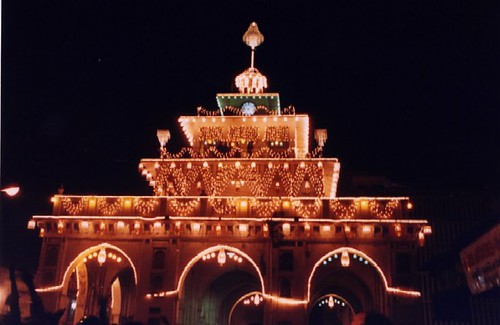

Khanderao Market is a palatial building that was built by Maharaja Sayajirao Gaekwad III in 1906. Named after Maharaja Khanderao Gaekwad (1856 – 1870), this building was presented by Sayajirao to the municipality as a gift on the silver jubilee of his administration. The building is now known to house several offices, including those of the Vadodara Municipal Corporation. In the back garden of the building is a vegetable market.


Sursagar Lake, formerly known as Chandan Talao, lies in the middle of the city of Vadodara. Rebuilt with stone banks and masonry in the 18th century, this lake remains full of water throughout the year. A concrete wall rings the lake that is often used by people to sit and enjoy the evenings. Vadodara Municipal Corporation has recently constructed a 120 ft tall statue of Lord Shiva in standing posture, in the middle of this lake.Several underground gates have been constructed to empty the lake in case it shows signs of overflowing. Water from these gates gushes to river Vishwamitri, which flows through the city of Vadodara. The lake is now being used for boating purposes, and looks extremely beautiful particularly on moonlit nights.




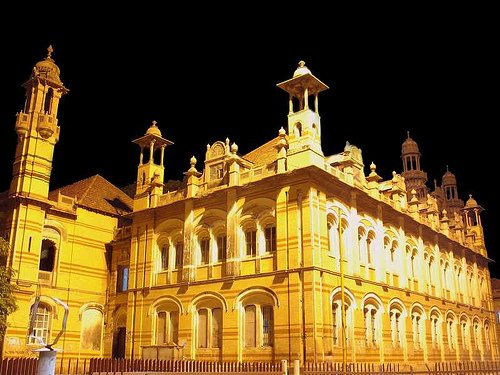











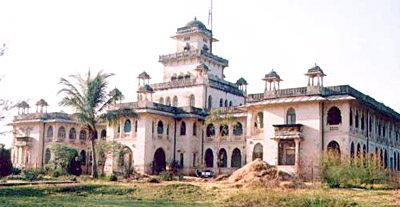
How to reach here:
By Air :Vadodara has an airport that is located outside the city and it has regular to flights to many important cities in the country such as Mumbai, Delhi, Kolkata, Ahmadabad, Chennai and Bangalore.
By Rail: The Vadodara Railway Station is an important part of the rail network in the state and there are frequent rail services from different places such as Mumbai (Dee Bdts G Rath), Chennai (Navjeevan Exp), Delhi (Mumbai Rajdhani), Bangalore (Coimbatore Exp) and most of the other places in the country.
Best time to visit: October to March.
Languages spoken: Gujarati, Hindi and English.
Must eat: Methi na Gota,Dahi Vada, Kansar, Jalebi.
Famous Restaurants: Kai Asia, Offside Lounge, 22nd Parallel, Azure, Barbecue nation.
Places you must visit:
Aurobindo Ashram served as the residence of Aurobindo Ghose during his stay in Baroda (1894 - 1906) as private secretary to HH Sayajirao Gaekwad III, Maharaja of Baroda. During this period, Aurobindo Ghose was also the Professor of English and vice-principal of Baroda College (now MSU). In the following years, he gained glory as a social and political thinker, a freedom fighter, a philosopher and a yogi, named Sri Aurobindo.The bungalow was then visited by famous people like Lokmanya Tilak, Bipin Chandra Pal, Sister Nivedita and Sakharam Ganesh Dueskar. Frequent visitors included wife Mrinalini Devi, sister Sarojini Devi and younger brother Barindar Kumar Ghose. The Niwas is now an ashram housing a library of Aurobindo literature, a study room and a sales emporium. The ashram features relics of Sri Aurobindo, and is open to all for meditation.




Maharaja Sayajirao University, commonly referred as M. S. University (MSU), is a teaching and residential university serving as one of the premier institutions of India. It was established in 1949 by Pratap Singh Gaekwad of Baroda, who named it after his grandfather Maharaja Sayajirao Gaekwad III. The university has its origins in the Baroda College of Science, which was established in 1881 by the Baroda State.The main building of this university, now housing the Faculty of Arts, was designed by Robert Fellowes Chisholm. Posing an Indo-Saracenic architecture style, the building features a confluence of Indian and Byzantine arches, and domes in brick and poly chrome stone. Other attractions of the university are Faculties of Fine Arts and Performing Arts and the Hansa Mehta Library that has over 700,000 books and old journals.The M. S. University offers education in all fields, including science, commerce, arts, law and many more. Unlike other universities in Gujarat, the medium of instruction for all courses in MSU is English. Spreading over approximately 275 acres of land, this university has roughly 25000 students on its rolls.


Laxmi Vilas Palace is a huge building of the Indo-Saracenic school that was built by Maharaja Sayajirao Gaekwad III in 1890. Designed by Major Charles Mant, this building is said to have been the largest private dwelling built till date. The interiors of this palace are reminiscent of a large European country house, and feature modern amenities like elevators. Presently, the palace serves as the residence of the royal family of Baroda.A striking feature of the palace is its Darbar Hall, which often serves as the venue of music concerts and other cultural events. Characteristic of a Venetian mosaic floor, Belgium stained glass windows and walls decorate with mosaic, this hall opens into an Italianate courtyard of water fountains. Besides, the 700 acres compound of the palace also houses other buildings such as the Moti Baug Palace and the Maharaja Fateh Singh Museum.The museum exhibits a rich collection of art works that belong to the royal family, including paintings of Raja Ravi Varma and others depicting Hindu mythology. Entrance of this beautiful museum is marked by a refurbished train engine of what was once a miniature railway line. Evidences of the past can be found elsewhere in the palace as well, such as the old armoury and sculptures in bronze, marble and terracotta by Fellici.


Kirti Mandir, or the Temple of Fame, is situated near the Vishwamitri Bridge towards the north of Maharaja Fateh Singh Rao Gaekwad's statue. This cenotaph was built by Maharaja Sayajirao Gaekwad III in 1936 to commemorate the cremation of his family members, and celebrate the diamond jubilee of his administration. Shaped like the alphabet 'E', this stone building is characteristic of domes, terraces and balconies.The 33 m high central shikhar is adorned with the sun, the moon and the earth in bronze and an undivided map of India. Inside the cenotaph are various rooms, featuring with the statues and photographs of the members of the royal family. The marble walls of this temple are decorated with the murals Gangavataran, battle of Mahabharata, Life of Meera and Natir Pooja, executed by the famous Bengali artist Nandalal Bose.
%20Vadodara%20Gujarat3.jpg)
,+Vadodara,+Gujarat12.jpg)
Tambekar Wada is a spacious, four-storey building that has been constructed in an oblong fashion. It is originally the former residence of the Baroda State Diwan or Minister, Bhau Tambekar, who owned the responsibility of the administration of the state. The walls, doors and ceilings on the first and second floors of this old fashion building are adorned with the best specimens of mural paintings dating back to 17th and 18th centuries.Other wall paintings dating back to the first half of the 19th century represent epic scenes depicting the life of the people. As the paintings have been made by some careless people, most of them had to be restored by the Archaeological Survey of India. The ASI still attend to the chemical treatments of these paintings on a frequent basis.
The scenic and impressive Vadodara Museum and Picture Gallery was built in 1894 AD by the Gaekwads. The museum has on display innumerable an extensive collection of artefacts relating to archaeology, geology, natural history and a variety of personal collection pieces of Maharaja Sayajirao III. Amongst the notable display, you can view the 109 miniature paintings of the Mughal times, a Persian version of Mahabharata specially commissioned by Mughal Emperor Akbar, 11th century Shiva Natraj amongst others.

Sayaji Gardens, popularly known as Kamati Baug, is the largest garden in Western India, spreading over 45 hectares of land. The garden is named after Maharaja Sayajirao Gaekwad III, who built it in 1879 on the river Vishwamitri. Besides the rich flora of more than 98 species of trees, this park encompasses two museums, a zoo, a planetarium and a flower clock.Built in 1894, the Baroda Museum and Picture Gallery within Sayaji Baug preserves a rich collection of art, sculpture, ethnography and ethnology. Major attractions of this museum include Egyptian mummy and skeleton of a blue whale. The picture gallery, which was opened in 1921, exhibits art works of British painters.The Floral Clock standing erect inside the park is the first of its kind in the state. The machinery of the clock is underground, and its hour, minute and seconds hands move on a 20 ft diameter dial.



EME Temple, often referred as the Dakshinamurti Temple, was built by the Electrical and Mechanical Engineering (EME) Corps. Featuring an unusually modern geodesic architecture, this temple is dedicated to Dakshinamurti, a form of Shiva as supreme teacher. It is run by Indian Army Authorities, and incorporates holy symbols of all religions in one place as they do not have separate places of worship for different faiths.Depicting army architecture, the aluminium building of this temple is ringed by a garden featuring a rich collection of 106 ancient statues from the 6th to the 16th centuries.

Qutbuddin Hajira is the mausoleum of Qutbuddin Muhammad Khan, who was a general in the army of Mughal Emperor Akbar and later the governor of his region. Locally known as Hajira, this monument is certainly the most important Mughal monument in Vadodara. Built in 1586, the tomb features beautifully carved stone windows and an old step-well in the large grounds surrounding it.

Mandvi Gate, often termed as the North gate of the Royal Enclosure, is one of the major landmarks in Vadodara dating back to the Mughal period. Built by Sultan Muzaffar (1511-26 AD), this square-shaped pavilion features three bold arched openings on each of its four sides. Marked by a market place in today’s time, this gate separates the two intermingled streets into four that meet in the center. Under the orders of Damaji Rao II, this gate was renovated by Governor Malharrao Maloji in 1736 AD. On special occasions like festivals and cultural events, the gate is illuminated with colorful lights. Near Mandvi Gate is a Central Library that has been inherited by the Gaekwads, and carries over 300,000 books in the present time.


Khanderao Market is a palatial building that was built by Maharaja Sayajirao Gaekwad III in 1906. Named after Maharaja Khanderao Gaekwad (1856 – 1870), this building was presented by Sayajirao to the municipality as a gift on the silver jubilee of his administration. The building is now known to house several offices, including those of the Vadodara Municipal Corporation. In the back garden of the building is a vegetable market.


Sursagar Lake, formerly known as Chandan Talao, lies in the middle of the city of Vadodara. Rebuilt with stone banks and masonry in the 18th century, this lake remains full of water throughout the year. A concrete wall rings the lake that is often used by people to sit and enjoy the evenings. Vadodara Municipal Corporation has recently constructed a 120 ft tall statue of Lord Shiva in standing posture, in the middle of this lake.Several underground gates have been constructed to empty the lake in case it shows signs of overflowing. Water from these gates gushes to river Vishwamitri, which flows through the city of Vadodara. The lake is now being used for boating purposes, and looks extremely beautiful particularly on moonlit nights.


Nazarbaug Palace, built in old classical style, was a Gaekwad Royal Palace erected by Malhar Rao Gaekwad in 1721. Made in white-stucco, this palace was the repository of the jewels of the Gaekwad family. In 1927, the palace was believed to house a collection worth INR 444,165,200, including a necklace adorned with 125 carat Star of the South diamond. A cloth embroidered with precious stones and seed pearls is also a part of this collection.The palace also owned barrels of solid gold and silver guns, each of which weighs more than 100 kg. Other displays at the palace are royal heirlooms and works of old masters like Raphael, Titian and Murillo. The collection also includes Indian Paintings, Graeco-Roman exhibits, Chinese and Japanese art. Once used on ceremonial occasions by the Gaekwads, this palace houses a Sheesh Mahal.


Nyaya Mandir, or the Temple of Justice houses the District Court of Vadodara city in the state of Gujarat. Built in 1896, this building features an Indo-Saracenic architecture designed by the Madras architect Robert Fellowes Chisholm. Elements of Gothic, Renaissance and Mughal architectural styles are also reflected in the building.The central hall of the building, which is adorned with mosaic tiles, is currently used as the Town Hall. Inside the central hall is a statue of Maharani Chimnabai, who was the first consort of Gaekwad Maharaja Sayaji Rao III (1875 – 1939).


Lehripura Gate, built in 1558, served as the western gateway to the old city. A towering structure with beautiful arches, the Lehripura Gate now serves as a busy market place famous for traditional Gujarati and Marwari artifacts.

Mahatma Gandhi Nagar Gruh was constructed in 1954, and serves as the town hall of the city. Fully air-conditioned, this town hall can accommodate thousands of people at one time and is thus used for various cultural functions. Within the town hall are three dressing rooms and a statue of Mahatma Gandhi standing in the compound.

Surya Mandir is one of the most legendary temples of Vadodara and is thus frequented by a large number of devotees. It is situated in the Surya Narayan Baug.

Makarpura Palace, designed in Italian style, was a Gaekwad royal palace built by Maharaja Khanderao in 1870. It was supposed to be the summer palace despite the fact that the royal family spent most of their summers in the Nilgiris of Tamil Nadu. Maharaja Sayajirao Gaekwad III extended the place and renovated it years after it was built.Presently, the 3-storey building of the palace is used by the Indian Air Force as a training school called No.17 Tetra School.

Sayaji Sarovar, also known as the Ajwa lake was formed by damming the Surya River and Vaghali Nala, the Sayaji Sarovar is the principal source of water in Vadodara. The site was designed by Shri Jagannath Sadashiv, and was constructed between 1885 and 1890. Sprawling across an area of 190 sq. km, this reservoir is 5 km in length and can store water to the height of 212 ft.Near the earthen dam is a beautiful garden, which is patterned similar to the famous Brindavan Gardens of Mysore.

Kadia Dungar Caves: Seven rock-cut caves and monolithic lion pillars are present at Kadia Dungar, near Bharuch. The caves suggest that they were viharas. A Brick stupa was also found in the foothills. These caves were in use during 1st and 2nd century AD.
Vadhvana Wetland & Eco Campsite is an irrigation reservoir and wetland located 10 kms from Dabhoi & 20 km from the Jambughoda village, is the water source for 25 nearby villages, and a popular bird-watching site for species including stork, tern, ibis, and spoonbill. Apart from being a wetland, it also has an eco tourism campsite. The best time to visit the wetland is from October to March cause that is the main migratory seasons for birds which migrate here from all over the world.


Chhota Udaipur, towards the border with Rajasthan shares a history with Devgadh Baria and Rajpipla as one of the three princely states of eastern Gujarat. The small town sits on the edge of a big lake, with a series of temples along the skyline. The Jain temple is an interesting example of the influence of Victorian art on local building styles. Structures from the 1920s such as the Kusum Vilas Palace(also a heritage hotel) and Prem Bhavan are also worth visiting, though they need permission from the local royal family.


Packers and Movers in Vadodara Have you ever approached a home improvement project, however did not have the proper tools? It in all probability took hours longer than necessary and was abundant tougher, simply because you wished to avoid wasting yourself a visit to the ironmongery store. If you wish to maneuver into a brand new house, you wish to approach it like that home improvement project -- however it may be exhausting to assemble all the materials you wish if you do not grasp what they are!
ReplyDeleteView for reliable relocation services to accommodate your needs from local household shifting, long distance residential remotion; office deviation, commercial goods relocation, joint relocation to international moving. The packers and movers in Bangalore will handle the relocation issues perfectly. The best deals of experienced and reputed packers and movers services compare potential companies to select the best available one.
ReplyDeleteThe best providing services offer condition moving, packing, transportation, loading, unloading and rearranging services at competitive price. The top rated packers and movers in Bangalore offer best match for your move.
http://fasttrackhomepackers.in/
My cousin recommended this blog and she was totally right keep up the fantastic work!
ReplyDeletepackers and movers Thoraipakkam
Vadodara is the city of beautiful temples, exotic museums, fascinating palaces and lavish gardens. number of best places to visit in vadodara attracts tourist here.
ReplyDeleteThank you for your detailed post about Vadodara, one of the eminent city of Gujarat. There are various places to visit in Vadodara which are popular among tourists like beautiful temples, museums etc.
ReplyDeleteThis article is so great! Thank you for sharing this is very useful Blog….
ReplyDeletePackers and Movers Miyapur
Best Packers and Movers in Miyapur
Local Packers and Movers Miyapur
Top Packers and Movers in Miyapur